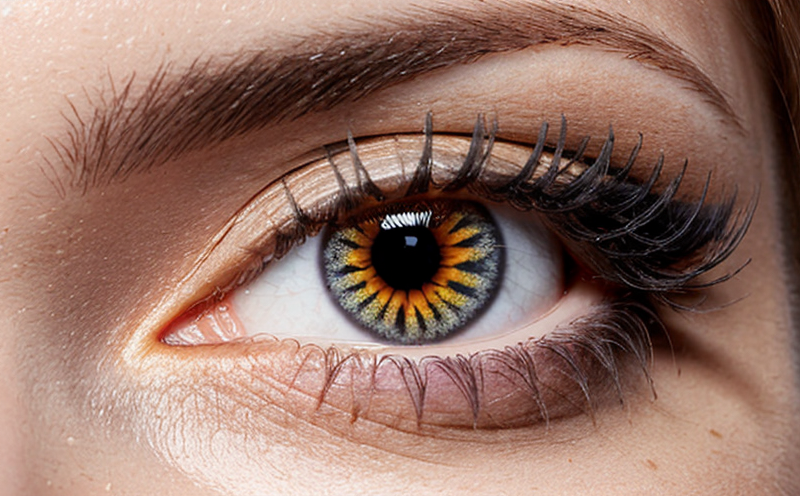Eye Irritation Testing for Eyeliner Pencils
The testing of eyeliner pencils for eye irritation is a critical component in ensuring product safety and compliance with international standards. This process involves assessing the potential adverse effects on ocular tissue when exposed to the eyeliner pencil during normal use or accidental contact. The aim is to prevent any form of discomfort, inflammation, or permanent damage to the eyes.
The primary testing protocols for this purpose include the ISO 10993-10:2018 standard, which outlines the requirements and procedures for biocompatibility testing of medical devices. While eyeliner pencils are not medical devices per se, many cosmetic products, including eyeliner pencils, must meet similar safety standards to ensure consumer protection.
The test requires the preparation of a standardized specimen, typically a small quantity of the eyeliner pencil, which is then applied to the conjunctiva (the thin layer of tissue covering the inside of the eyelids and the outer surface of the eye). The application is done under controlled conditions that mimic real-world scenarios where the product might come into contact with the eyes. A control group without exposure serves as a baseline for comparison.
The test specimens are observed over several hours, typically up to 48 hours post-application, to monitor any signs of irritation such as redness, swelling, or discharge from the eye. The observations are recorded and compared against the control group to determine if there is an adverse reaction. If significant irritation is detected, further tests may be necessary to identify specific allergens or irritants.
This testing procedure is essential for cosmetic manufacturers aiming to ensure their products meet rigorous safety standards. It helps in identifying potential issues early in the development process, allowing for corrective measures to be implemented before product release. The results of this test are often required by regulatory bodies such as the European Union's Cosmetics Regulation and other global standards.
The significance of such testing extends beyond mere compliance; it reflects a commitment to consumer safety. By adhering to these stringent protocols, manufacturers can build trust with consumers who value product safety and quality. The findings from these tests are crucial in formulating policies for the use of raw materials and ensuring that products are safe for all users.
It is important to note that the testing process not only protects end-users but also the manufacturers by mitigating potential legal risks associated with product liability lawsuits. This proactive approach towards safety ensures a safer market environment where consumers can make informed choices about their cosmetic purchases.
Industry Applications
- Manufacturing Compliance: Ensures that eyeliner pencils adhere to the stringent requirements set by regulatory bodies like the European Union's Cosmetics Regulation.
- R&D Innovations: Identifies potential allergens and irritants in new formulations, facilitating safer product development.
- Quality Assurance: Guarantees that eyeliner pencils meet international safety standards before they reach the market.
Competitive Advantage and Market Impact
Compliance with eye irritation testing for eyeliner pencils can significantly enhance a company's reputation in the cosmetics industry. By demonstrating a commitment to product safety, companies can attract more customers who value health and safety above all else. This can lead to increased market share and customer loyalty.
The results of these tests are not only important for compliance but also serve as marketing tools. Consumers today are increasingly conscious about what they put on their skin and eyes, making it essential for brands to highlight their adherence to rigorous testing protocols. This transparency can differentiate a brand from its competitors, positioning them as leaders in safety and quality.
In addition, successful completion of these tests opens doors to international markets where stringent regulations are enforced. Many countries have specific requirements for cosmetics products, including eye irritation testing, which must be met before they can be sold within their borders. By meeting these standards, manufacturers can expand their reach and tap into new consumer bases.
From a competitive standpoint, companies that invest in thorough safety testing like this not only meet regulatory demands but also set higher benchmarks for themselves. This proactive approach to quality control can lead to better product performance and reduced risk of recalls or lawsuits, ultimately contributing to long-term profitability and sustainability.
Use Cases and Application Examples
| Use Case | Description |
|---|---|
| New Product Launch: | Testing eyeliner pencils for eye irritation is mandatory during the launch phase of new cosmetic products to ensure compliance with international standards. |
| R&D Prototyping: | During the research and development stage, testing can help identify any potential allergens or irritants in prototype formulas before they are finalized for production. |
| Batch Quality Control: | Regular batch testing ensures that each batch of eyeliner pencils meets the required safety standards, thereby maintaining consistent product quality. |
| Ingredient Reassessment: | If there is a change in raw materials or production processes, retesting is necessary to ensure no new allergens or irritants are introduced into the formula. |





